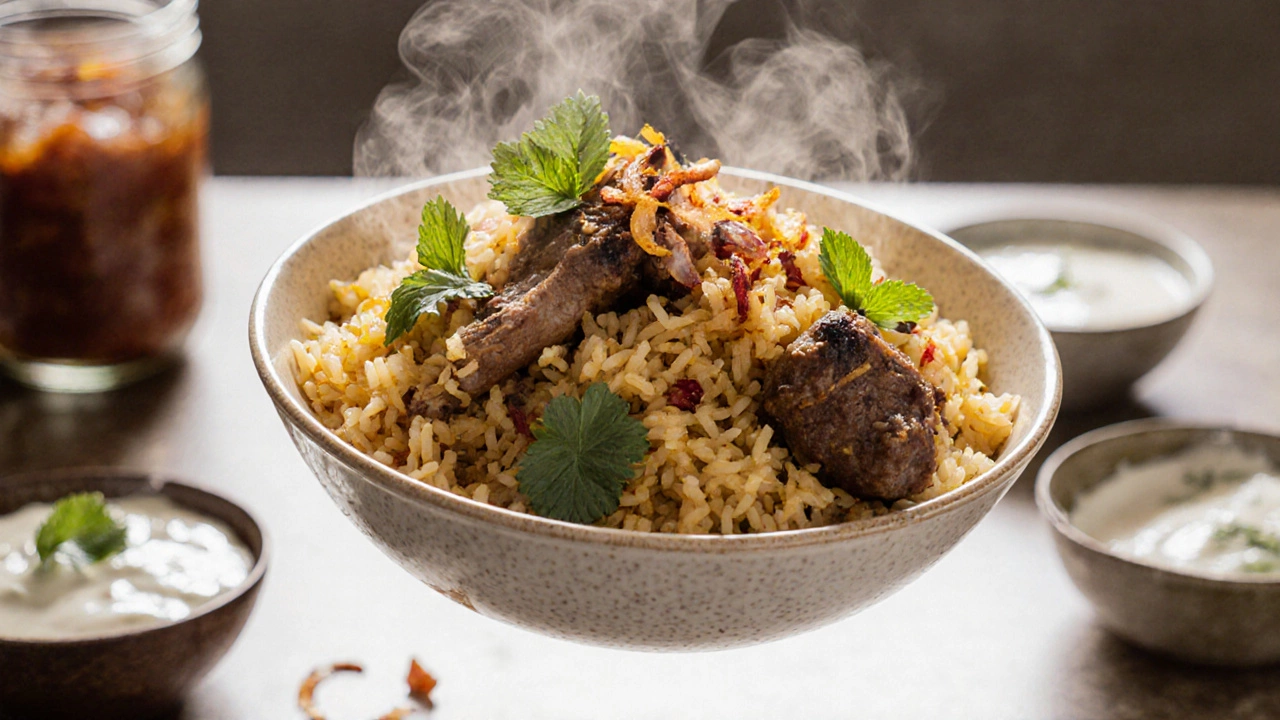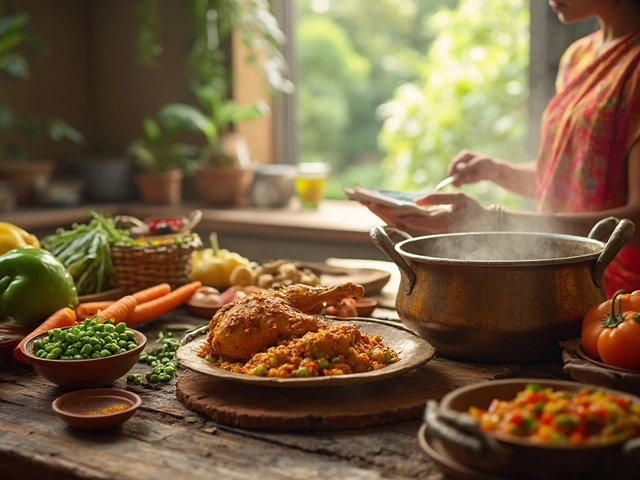Biryani Texture & Doneness Checker
Get perfect texture every time with this tool based on the article's pro tips. Enter your rice cooking time and meat type to see if you're at the sweet spot for 70% doneness and ideal dum time.
Result
Everyone’s had that moment-stirring a pot of biryani, smelling the steam rise, and thinking, it’s good… but it could be better. Maybe the rice is a little dry, the meat’s bland, or the aroma fades too fast. You followed the recipe. You used the right spices. So why doesn’t it taste like the biryani your aunt makes-or the one you had in Hyderabad?
The truth? Biryani isn’t about following steps. It’s about layering flavor. Every ingredient, every step, every pause matters. You don’t just cook biryani-you build it, like a slow-burning fire. Here’s how to make it taste like it’s been simmering for hours, even if you only had two.
Start with the rice-quality and prep make all the difference
Basmati rice is non-negotiable. But not all basmati is equal. Look for aged basmati, preferably 1-2 years old. Older rice has less moisture, so it cooks longer and stays separate, not sticky. If you’re using fresh basmati, soak it for 30 minutes before cooking. That one step alone cuts down on overcooking and gives you those long, fluffy grains that hold up under steam.
Don’t boil the rice until it’s fully cooked. Stop when it’s 70% done-still firm in the center. That’s your foundation. The rest of the cooking happens in the dum (steaming) stage. If you overcook it now, you’ll end up with mush. Undercooked? You’ll get hard bits. 70% is the sweet spot.
Marinate the meat like it’s a ritual
Skipping the marinade? That’s like putting a shirt on without washing it first. You can’t skip it. Even if you’re short on time, marinate the chicken, lamb, or beef for at least 2 hours. Better yet, overnight.
Use yogurt-not just for tenderness, but for flavor carrier. Yogurt holds spices close to the meat and slowly releases them as it cooks. Add minced garlic, ginger, a teaspoon of turmeric, a tablespoon of red chili powder, and a pinch of saffron soaked in warm milk. Salt? Yes, but don’t add it all yet. Save half for layering later.
Pro tip: Add a tablespoon of lemon juice or amchoor (dry mango powder) to the marinade. It brightens the meat without making it sour. That subtle tang is what separates good biryani from unforgettable biryani.
Toast your spices-don’t just dump them in
Ground spices are useful, but whole spices are magic. Cumin seeds, cardamom pods, cloves, cinnamon sticks, bay leaves, black peppercorns-these are your flavor architects. Heat ghee or oil in a heavy-bottomed pot. Add the whole spices and let them sizzle for 30 seconds until they release their oil. Don’t burn them. Just let them wake up.
Now add your onions. Not just chopped. Thinly sliced, and cooked slowly until they turn deep golden brown-almost caramelized. This is where the sweetness comes from. Rush this, and your biryani tastes flat. Take your time. 15-20 minutes. Stir occasionally. Let them melt into the oil.
Then add your ground spices: coriander, cumin, turmeric, garam masala. Cook them for 1 minute, stirring constantly. This isn’t seasoning-it’s activation. Raw spices taste bitter. Toasted spices taste like home.
Layer like a pro-this is where most go wrong
Here’s the secret: biryani isn’t mixed. It’s layered. Think of it like lasagna, but with rice and meat instead of pasta and sauce.
Start with a layer of partially cooked rice. Then a layer of marinated, browned meat. Sprinkle fried onions on top. Then a drizzle of saffron milk. Then a handful of fresh mint and coriander leaves. Then a pinch of salt. Then another layer of rice. Repeat. Top it off with more saffron milk, fried onions, and a few drops of rose water.
Use a tight lid. Seal it with dough or a damp cloth under the lid. That’s the dum-steam trapped, flavors locked in. Cook on low heat for 20-25 minutes. No peeking. Let the steam do the work.

Don’t forget the garnishes-they’re not optional
Those crispy fried onions? They’re not just for looks. They add crunch and a deep, sweet smokiness that cuts through the richness. Make them yourself. Thinly slice onions, fry in ghee until golden, then drain on paper towels. Store them in a jar. You’ll use them on everything.
Saffron is expensive, but you only need a pinch. Soak 10-12 strands in 2 tablespoons of warm milk for 15 minutes. That milk becomes liquid gold. Drizzle it over the top. It’s not just color-it’s perfume.
Fresh herbs matter too. Mint and coriander aren’t garnish. They’re flavor bombs. Add them in layers, not just on top. Chop them finely. Sprinkle between layers. You’ll taste them in every bite.
Let it rest-patience is the final spice
When the dum is done, don’t rush to serve. Turn off the heat. Leave the pot covered for 10 minutes. Let the steam settle. Let the flavors marry. This is the moment the biryani becomes more than the sum of its parts.
When you lift the lid, the aroma should hit you like a warm hug. The rice should be separate, not clumped. The meat should fall off the bone. The spices should linger on your tongue-not punch you in the face.
Common mistakes that ruin biryani (and how to fix them)
- Rice is sticky? You overcooked it. Next time, stop at 70%. Rinse the rice until the water runs clear before soaking.
- Meat is tough? You didn’t marinate long enough, or you cooked it too fast. Low and slow is the rule. Use bone-in meat-it adds depth.
- Flavor is flat? You skipped the whole spices or toasted them too briefly. Toast them in ghee, not water. Ghee carries flavor better.
- Too oily? You used too much oil or didn’t drain the fried onions. Use just enough ghee to carry the spices. Skim excess oil before layering.
- Not aromatic enough? You forgot the saffron or rose water. Even a few drops make a difference. Don’t skip them.

What to serve with biryani
Don’t drown it in sauces. Biryani is the star. Serve it with a simple raita-yogurt, grated cucumber, a pinch of roasted cumin, and a dash of mint. Or a quick onion salad: thinly sliced red onions soaked in vinegar and water for 10 minutes, then drained.
Some like a side of mirchi ka salan or a spicy green chutney. Keep it light. You want to cleanse the palate, not overwhelm it.
Can you make biryani in a pressure cooker?
Yes-but it’s not the same. Pressure cookers speed up cooking, but they don’t build layers. You can brown the meat and toast the spices in one pot, then layer the rice and meat, seal the lid with foil, and cook on low for 10 minutes after pressure releases. It won’t be perfect, but it’ll be close. For the real thing? Stick to the dum method.
Leftovers? Reheat it right
Never microwave biryani. It turns the rice to rubber. Reheat it in a covered pot on the stove with a splash of milk or water. Add a few drops of ghee. Cover and steam for 5 minutes. That’s how you bring it back to life.
Can I use pre-cooked rice to make biryani?
No, not really. Pre-cooked rice is already fully hydrated and cooked through. When you layer it, it’ll turn mushy under steam. Biryani needs rice that’s partially cooked so it finishes steaming slowly with the meat. Use raw, soaked basmati instead.
What’s the best meat for biryani?
Bone-in lamb or chicken thighs are best. The bones release collagen and flavor as they cook, making the meat tender and the gravy rich. For chicken, skin-on thighs stay juicier. For lamb, shoulder or leg cuts work well. Avoid lean cuts like breast-they dry out.
Can I make biryani without saffron?
Yes, but you’ll lose the signature aroma and golden hue. Saffron isn’t just color-it’s fragrance. If you can’t find it, use a pinch of turmeric for color and a drop of rose water or kewra water for fragrance. It won’t be the same, but it’ll still be good.
Why does my biryani smell too spicy?
You likely added too much chili powder or didn’t toast the spices properly. Raw chili powder tastes harsh. Toasting whole spices first, then adding ground spices for just a minute, balances the heat. Also, use Kashmiri red chili powder-it’s bright red but mild. Avoid cayenne unless you want fire.
How do I make biryani vegetarian?
Swap the meat for paneer, potatoes, carrots, peas, and cauliflower. Fry the vegetables lightly before layering. Use the same spice blend and marinate paneer in yogurt and spices for 30 minutes. Add a splash of cashew paste for creaminess. It’s just as rich.
Make biryani once, and you’ll understand why it’s more than a dish. It’s tradition, patience, and memory in a pot. The next time you make it, don’t just follow the steps. Taste as you go. Adjust. Trust your nose. The best biryani isn’t the one that looks perfect-it’s the one that makes you close your eyes and smile.











